Did you know that businesses using advanced financial planning tools can improve their forecasting accuracy by up to 25%?
This significant improvement is largely due to the integration of sophisticated technologies that analyze historical data, market trends, and external variables to predict revenue, expenses, and cash flow more effectively.
As financial planning becomes increasingly complex, leveraging tools that utilize advanced algorithms is crucial for businesses and individuals seeking to make informed decisions.
The right software can dynamically update forecasts, detect anomalies, and provide scenario modeling, enabling users to adjust budgets, optimize spending, and mitigate risks proactively.
Key Takeaways
- Overview of leading AI financial planning tools in 2025
- How AI-powered financial planning improves accuracy and efficiency
- Key categories of financial planning tools for businesses and individuals
- Evaluation criteria for assessing financial planning software
- Importance of data analysis in financial decision-making
The Evolution of Financial Planning with AI

The integration of AI in financial planning has revolutionized the way businesses approach financial decision-making. Traditionally, financial planning relied heavily on manual processes and spreadsheet-based approaches, which were time-consuming and prone to errors. However, with the advent of AI-powered tools, financial planning has become more efficient, accurate, and data-driven.
How AI is Transforming Financial Decision-Making
AI is transforming financial decision-making by introducing advanced capabilities such as predictive analytics, pattern recognition, and automated data processing. These capabilities enable businesses to make informed decisions based on comprehensive data analysis, reducing the risk of human bias and errors. By automating repetitive tasks like data collection and basic reporting, AI allows finance teams to focus on higher-value activities such as strategy and decision-making, thereby saving time and improving the reliability of financial outputs.
For instance, businesses can leverage AI-powered apps to track their expenses smartly, gaining valuable insights into their financial data.
Key Benefits of AI-Powered Financial Tools
The key benefits of AI-powered financial tools include improved forecast accuracy, enhanced risk management, and the ability to generate actionable insights from complex financial data. By leveraging these tools, businesses can streamline their financial planning process, making it more efficient and effective. Additionally, AI-powered tools provide real-time insights and dashboards, enabling businesses to respond promptly to changes in the market and make data-driven decisions.
Overall, the adoption of AI in financial planning is revolutionizing the finance sector by providing businesses with the tools they need to make informed, strategic decisions.
Essential Features of AI Financial Planning Tools in 2025
AI financial planning tools are revolutionizing the way organizations and individuals manage their finances, with several key features defining their capabilities in 2025. These tools are designed to enhance financial planning processes, making them more efficient and effective.
Automated Data Analysis and Reporting
One of the critical features of AI financial planning tools is automated data analysis and reporting. This feature eliminates manual processes, reducing errors and freeing up finance teams to focus on strategic activities. By automating data collection and consolidation, these tools provide timely and accurate reports, enabling better decision-making.
Predictive Forecasting Capabilities
AI financial planning tools also offer advanced predictive forecasting capabilities. By leveraging machine learning algorithms, these tools analyze historical financial data to generate accurate projections, identify trends, and model multiple scenarios. This enables organizations to make informed decisions and prepare for potential future outcomes. For more information on how AI is transforming financial decision-making, visit this resource.
Real-Time Insights and Dashboards
Another essential feature of AI financial planning tools is the provision of real-time insights and dashboards. These features provide immediate visibility into financial performance, enabling proactive responses to changing conditions. With real-time data, organizations can adapt quickly to new information, making their financial planning processes more agile and responsive.
Fuelfinance: Comprehensive Financial Management for SMBs
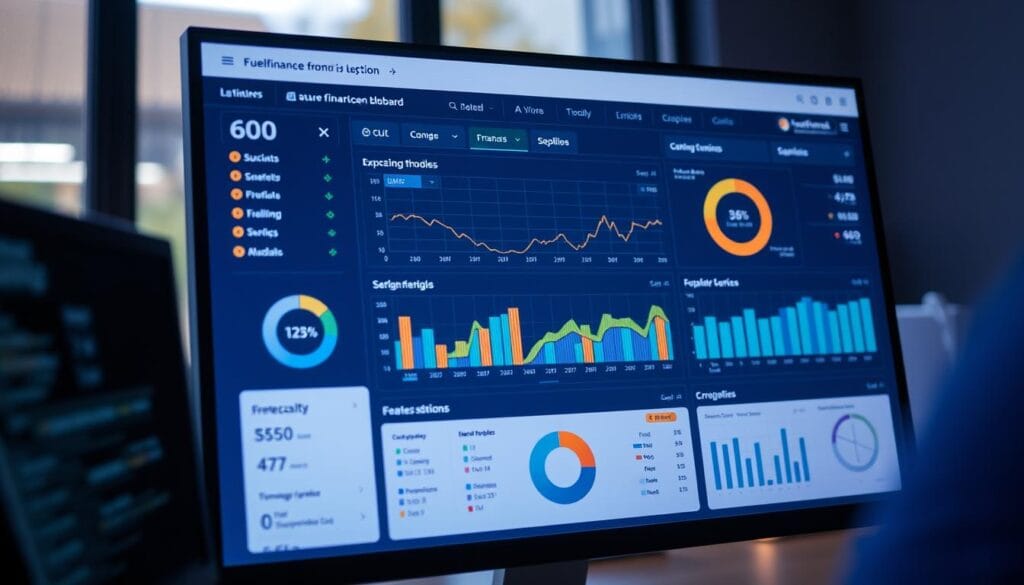
In the realm of financial management for SMBs, Fuelfinance stands out as a leading AI-powered solution. Fuelfinance is a comprehensive financial management platform designed to help startups and SMBs easily forecast, plan, and automate their finances. By leveraging AI forecasting models, Fuelfinance analyzes historical financial data to detect market trends and identify potential risks, thereby enabling businesses to make informed decisions.
Overview
Fuelfinance’s core value proposition lies in its ability to automate financial processes, generate accurate forecasts, and provide actionable insights without requiring extensive financial expertise. This makes it an ideal tool for SMBs looking to streamline their financial management.
Key Features
The platform boasts several key features, including AI forecasting models that predict revenue and expenses, automated financial statement generation, an all-in-one financial dashboard, and smart KPI tracking tailored to specific business models. These features work in tandem to provide a comprehensive view of a company’s financial health.
Pros and Cons
Fuelfinance’s strengths include its user-friendly interface and comprehensive reporting capabilities. However, potential limitations such as integration constraints and pricing considerations for very small businesses should be noted. Overall, Fuelfinance offers a robust solution for SMBs seeking to enhance their financial planning capabilities.
Pricing and Plans
Fuelfinance offers various pricing plans designed to accommodate different business needs. For detailed information on the available plans and their respective features, users can visit the Fuelfinance website or explore other financial planning tools to compare offerings.
Enterprise-Level AI Financial Planning Solutions
Large organizations with complex financial structures require sophisticated AI financial planning solutions to manage their extensive planning needs across multiple departments. These solutions enable businesses to streamline their financial planning processes, improve accuracy, and make informed decisions.
Anaplan: Connected Planning Platform
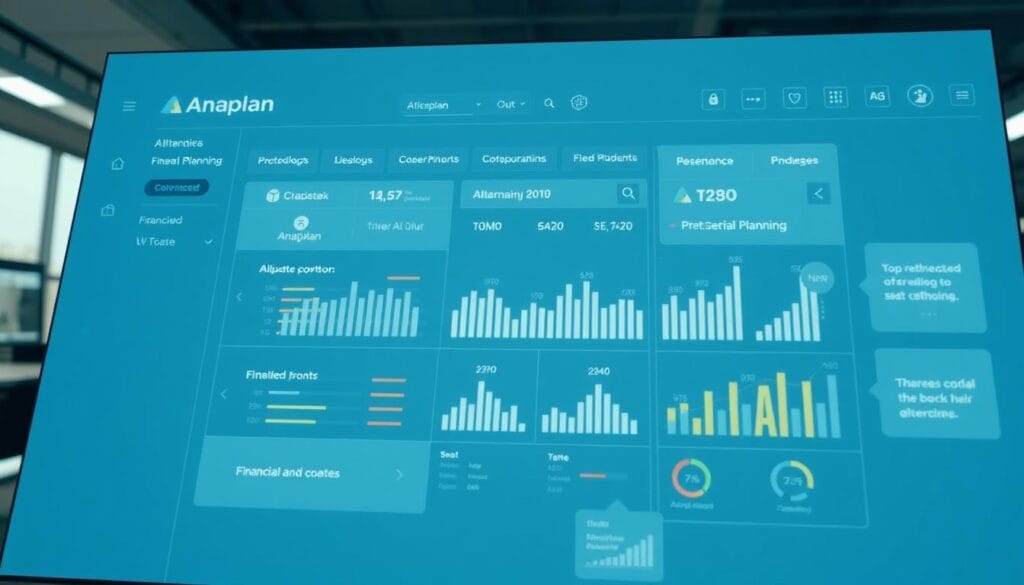
Anaplan is a robust enterprise-level financial planning platform designed for large businesses with intricate financial structures. It facilitates collaboration among various departments, including finance, HR, sales, and supply chain, on budgeting, forecasting, and scenario modeling. Anaplan’s PlanIQ feature leverages machine learning for predictive analytics, enabling businesses to anticipate future trends and make proactive decisions.
The platform allows for multi-dimensional modeling, facilitating scenario planning across different business variables. This capability, combined with AI-driven insights, helps optimize resource allocation and drive business performance. By integrating financial planning with operational activities across the enterprise, Anaplan provides a comprehensive view of the organization’s financial health.
For more information on how AI-powered tools can enhance financial planning, visit https://aimoneymatters.com/get-tailored-budget-advice-with-ai-powered-tools/.
Workday Adaptive Planning: Workforce and Financial Forecasting

Workday Adaptive Planning is a financial planning and forecasting platform tailored for large enterprises managing complex budgets, workforce planning, and operational efficiency forecasting. It offers driver-based forecasting capabilities, allowing finance teams to create baseline forecasts based on key business drivers and model multiple scenarios.
The platform’s anomaly detection features help identify unusual patterns in financial data, enabling proactive measures to mitigate risks. By integrating workforce planning with financial forecasting, Workday Adaptive Planning provides a holistic view of the organization’s performance and future prospects.
This integrated approach enables businesses to align their financial planning with operational efficiency, driving strategic decision-making and improving overall business outcomes.
Mid-Market AI Financial Planning Tools
AI financial planning tools are becoming essential for mid-market businesses seeking to improve their financial decision-making. These tools offer sophisticated capabilities that cater to the specific needs of mid-market companies, providing a balance between complexity and functionality. In this section, we will explore three prominent AI financial planning tools designed for mid-market businesses: Planful, Vena Solutions, and Pigment.
Planful: Process-Driven Financial Management

Planful is a financial performance management platform that follows a structured, process-driven approach to financial planning. It offers features such as automated data analysis, rolling forecasts, and accounting automation, helping mid-market companies streamline their financial planning processes. According to a recent survey, two-thirds of financial planning firms believe that technology will significantly shape the future of financial planning (Source: IFA Magazine).
Planful’s structured workflows enable finance teams to manage their financial planning processes more efficiently, reducing manual errors and improving collaboration.
Vena Solutions: Excel-Based FP&A with AI
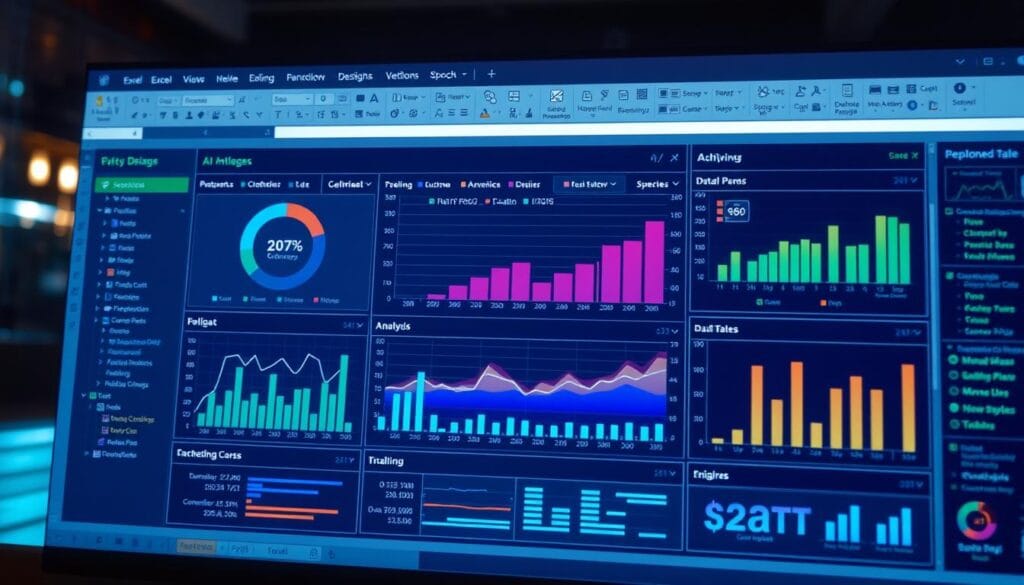
Vena Solutions is an FP&A platform that integrates directly with Microsoft Excel, allowing finance teams to leverage familiar spreadsheet interfaces while benefiting from advanced AI-driven analytics. Key features include automated data consolidation, collaborative planning, and advanced forecasting capabilities. Vena’s solution enables mid-market companies to enhance their financial planning processes without requiring significant changes to their existing workflows.
Pigment: Visual Business Planning Platform
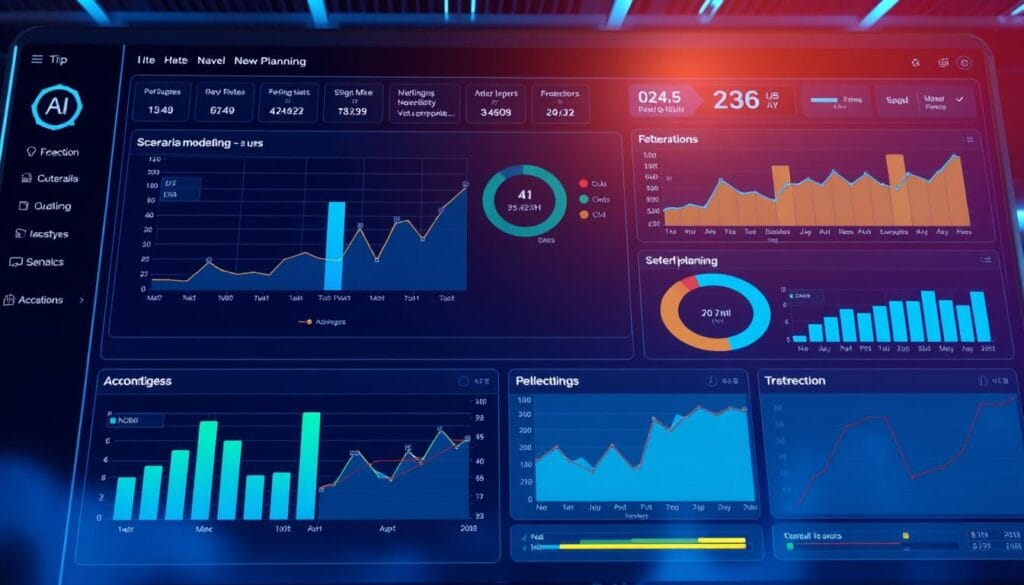
Pigment is a business budgeting platform that brings together finance, HR, sales, and operations into one system for budgeting, forecasting, and scenario modeling. Its intuitive interface and AI planning assistant help users navigate complex financial models and answer financial questions, making it an ideal solution for mid-market companies seeking to improve their financial planning and collaboration across departments.
By leveraging Pigment, mid-market businesses can enhance their financial decision-making and respond more effectively to changing market conditions.
Spreadsheet-Enhanced AI Financial Planning Tools
The integration of AI with traditional spreadsheet interfaces is revolutionizing financial planning for businesses. By building upon the familiar spreadsheet environment, AI-enhanced financial planning tools provide advanced capabilities while maintaining the flexibility and familiarity that many finance professionals prefer.
Cube Software: Multi-Scenario Financial Modeling
Cube Software is a scenario planning and AI forecasting tool that enables businesses to budget, forecast, and model financial scenarios directly within Excel or Google Sheets. Its multi-scenario financial modeling capabilities allow companies to create and compare different financial scenarios by adjusting key business drivers.
Key Features: Automated data consolidation and validation, customizable dashboards for visualizing financial performance, and enhanced collaboration among finance team members.
Cube Software automates data consolidation and validation, reducing manual errors and increasing efficiency. Its customizable dashboards provide real-time insights into financial performance, enabling finance teams to make informed decisions.

Datarails: Excel-Based FP&A with AI Insights
Datarails is a financial planning and analysis (FP&A) platform that automates budgeting, forecasting, and reporting while continuing to work in Excel. Its FP&A Genius feature provides instant insights on budgeting and forecasts, identifying trends and answering financial planning questions.
Key Benefits: Enhanced financial planning accuracy, improved forecasting, and streamlined reporting processes.
Datarails’ AI-driven insights enable finance teams to focus on strategic decision-making rather than manual data analysis. By automating routine tasks, Datarails allows businesses to respond quickly to changing market conditions.

Both Cube Software and Datarails bridge the gap between traditional financial planning methods and advanced AI capabilities, making them valuable for organizations transitioning to more sophisticated planning approaches.
AI Financial Planning Tools for Personal Finance
As individuals increasingly seek to manage their finances more effectively, AI financial planning tools have emerged as a vital resource for personal finance management. These tools leverage advanced technologies to provide users with personalized financial insights, helping them make informed decisions about their financial resources.
Investment and Wealth Management
Personal Capital is a powerful player in AI-driven personal finance tools, mainly known for its investment management capabilities. It offers portfolio analysis features, retirement planning calculators, and asset allocation insights that help individuals track and optimize their investments. By providing a comprehensive view of one’s financial situation, Personal Capital enables users to make more informed investment decisions.
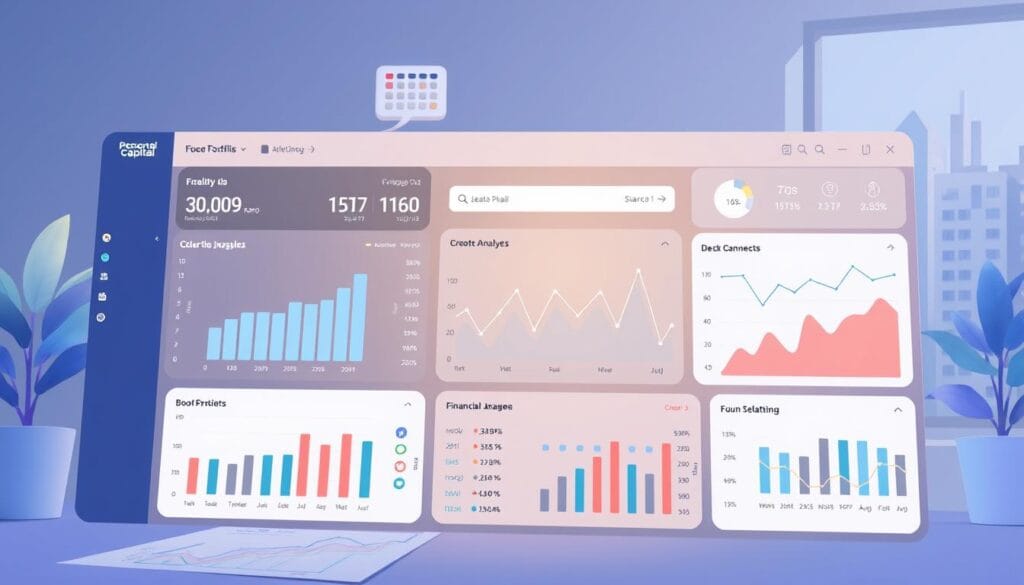
Comprehensive Budget Tracking
Mint is one of the most popular AI-driven personal finance tools available today, designed to help users manage their finances effortlessly. Its comprehensive budget tracking functionality includes automatic transaction categorization, insights into spending patterns, and alerts for unusual spending or upcoming bills. By utilizing Mint, individuals can gain a clearer understanding of their financial habits and make necessary adjustments.
![]()
Proactive Budgeting
YNAB, or You Need a Budget, is not just a budgeting tool; it’s a philosophy that encourages users to take control of their finances by giving every dollar a job. YNAB’s AI-enhanced features help users prioritize spending, embrace actual expenses, and build better financial habits. By adopting YNAB’s proactive budgeting approach, individuals can achieve greater financial stability and confidence.

Conversational Financial Assistant
Cleo is an innovative AI-driven personal finance tool that uses a chatbot interface to engage users in a fun and interactive way. By leveraging natural language processing, Cleo provides personalized financial advice and makes financial management more accessible and less intimidating. Through its conversational interface, Cleo helps users understand their financial situation and make informed decisions.
Generate an image of Cleo’s conversational interface
For more information on personal finance apps, you can visit this resource to explore a comprehensive list of tools designed to help manage your finances effectively in 2025.
How to Choose the Right AI Financial Planning Tool
Selecting the ideal AI financial planning tool is crucial for effective financial management. The best tool depends on your specific financial planning needs, making it essential to assess these needs before making a decision.
Assessing Your Financial Planning Needs
To choose the right tool, start by identifying your key financial planning requirements. Consider factors such as the complexity of your financial structures, reporting requirements, and forecasting needs. For instance, Fuelfinance is ideal for startups and SMBs, offering AI financial forecasting, cash flow tracking, and multi-scenario planning.
Integration Capabilities and Scalability
Another critical factor is the tool’s ability to integrate with existing systems and scale with your growing needs. Ensure that the chosen tool can accommodate increasing data volumes and adapt to evolving business requirements. As emphasized by industry experts, “The right AI financial planning tool should not only meet current needs but also be flexible enough to support future growth.”
By carefully evaluating your needs and considering the integration capabilities and scalability of AI financial planning tools, you can make an informed decision that supports your financial planning goals.
Conclusion: The Future of AI in Financial Planning
As AI continues to evolve, financial planning is on the cusp of a revolution. AI forecasting gives users a clear view of what’s ahead, eliminating budget surprises and cash flow shocks. Advances in machine learning algorithms and increased data accessibility are driving innovation in AI financial planning tools.
Emerging capabilities like natural language processing and advanced anomaly detection will become standard features. To stay ahead, users should focus on continuous learning and balancing technological innovation with sound financial principles, leveraging data insights for informed financial planning decisions.

